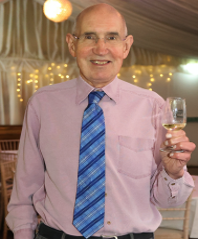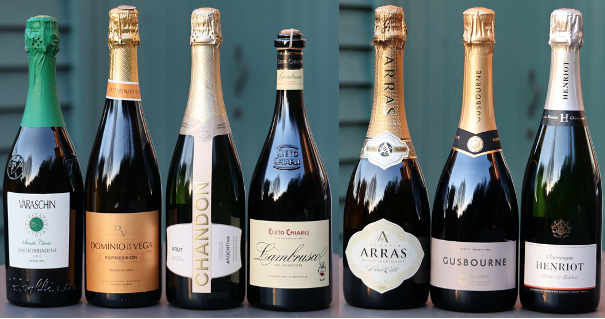
The Club’s very own Champagne expert, Graham Harding, stepped in at short notice to pull together this tasting when we were let down by another presenter, so Graham deserves a ‘special mention in despatches’ for pulling together such a splendid event.
All the wines tasted were gold medal winners at the 2024 Champagne and Sparkling Wine World Championships, which bills itself as ‘the most respected, comprehensive and rigorous international sparkling wine competition in the world’. Judges include Tom Stevenson.
Graham started the evening with a fun quiz – do you know which British Prime Minister drank a pint of champagne at 11am each day? Or how many times James Bond drank champagne on screen? (Answers – Winston Churchill and 43, but 63 in the novels) Emphasising the marketing prestige of such product placement, we learned that Bollinger pay £10m per film for their champagne to be used. An even more eye-watering figure is paid for the rights to have champagne sprayed around on the winner’s podium at racing’s Grand Prix - $100m per annum we were told, paid by LVMH.
We were then whizzed through the basics of what makes a sparkling wine – think a high acid, low sugar base wine from generally cool climates. Methodology was also reviewed: tank and bottle, pumping in CO², tank fermentation and bottle fermentation and a reminder that quality comes from the bottle fermented end of the spectrum.
More interesting facts and figures including Stalin’s 5-year plan to ensure the Russian worker could enjoy champagne ‘just like the Western bourgeoisie’: Asda employee Steve who saved up enough bottles of sparkling wine to give his wife a champagne bath on her birthday (“she nearly popped her cork!”) and that it can take up to 200 bottles to fill a bath. (If you want to try it apparently the Cadogan Hotel charges between £4k and £25k for a champagne bath – you also get a bottle to drink and some chocolate covered strawberries.)
Did you know that Christopher Merret, who was the first to document the deliberate addition of sugar for the production of sparkling wine, was a Worcester College man? There is a copy of his paper to the Royal Society in the college library.
Another British connection – it was Sir Kenelm Digby who developed robust glass bottles, made from the ‘verre Anglais’ which enabled wine and cider-makers to produce bottle-fermented sparkling wines and ciders. Before that, sparkling wine was known as the ‘Devil’s Wine’ because bottles exploded in the cellars due to the pressure caused by the secondary fermentation and barrels split their staves.
On to the wines and a challenge – can you tell the very good from the good!

- Varaschin Strada Chiesa Prosecco NV 11.5%abv £18.70
Winner of the gold medal as the best Prosecco. Made from 100% Glera. Hand harvested. Made using the Martinotti method according to the Prosecco di Valdobbiadene DOCG specifications. Residual sugar c 15g/ltr. Acidity given as 5.5gr/ltr, which led to a discussion about the impact of leaving a sparkling wine until it is flat and how much additional acidity/ph that might cause and whether it might be measurable. On the palate the sweetness was discernible with notes of white flowers, pear and ripe apple. Relatively large bubbles. Serve very chilled (to suppress the flavour!!!)
- Dominio de la Vega Cava 2021 12% abv £14.95
Gold medal for Spain’s best Cava. 100% Macabeo. Darker in colour than the Prosecco. The term Cava has only been used since the 1970s, before that it was referred to as Spanish champagne. Hand harvested and sorted. Made using the ‘méthode traditionelle’. 18 months on the lees. Grown at 750m altitude in clay soil west of Valencia. Hints of burnt rubber on the nose and palate. There was some bottle variation.
There are now ageing requirements for classifications of Cava:
Cava Reserva – 9-18 months
Cava de Guarda Superior 18- 30 months
Cava de Guarda Gran Reserva 30-36 months
Cava de Paraje Calificado – special category for very aged wines.
- Chandon Brut NV Argentina 12% abv £20
Chandon is the brand name used by Moët & Chandon for their non-French sparkling wines. This range now includes wines produced in California, Brazil, Australia, India and China as well as Argentina. The Argentinian operation was set up in 1959. It is produced from estate-owned vineyards in the Uco Valley in Mendoza’s Andes, which are at an altitude of between 1200 and 1450 metres. 60% chardonnay and 40% pinot noir. Méthode traditionelle. Fermented in stainless steel tanks with more than 18 months spent on the lees. Aged for 3 months in the bottle. Dosage is around 6gr/ltr. We debated whether this really tastes like champagne. It was felt the terroir and altitude show through, with distinct tropical fruit notes, however it was fresh and long. Perhaps an interesting future tasting might be of the various expressions of Chandon versus a Moët & Chandon champagne?
- Cleto Chiarli Lambrusco 2023, 11.5% abv £18.10
Gold medal for best Lambrusco. This wine was met with a universal groan when it was poured – perhaps it brought back embarrassing memories of the ‘Black Tower’ epoch and student hangovers? Made using the ‘metodo tradizionale’ – second fermentation in bottle. 100% Lambrusco di Sorbara grapes grown on sandy soil with a southern exposure. Deep pink in colour, tinned strawberries on the nose and palate, persistent mousse. Graham assured us this wine has a long history with mentions in Virgil – he also tried (but generally failed) to persuade us it would be a delicious accompaniment to salami eaten outdoors in the summer.
Wines 5, 6 and 7 were served together so that direct comparisons could be made since all are made using some or all of the three main champagne grapes and the traditional method of champagne-making.
- House of Arras Brut Elite, Tasmania, Australia 13% abv £40
The House of Arras 2006 E.J Carr Late Disgorged won Gold as best Australian Brut Blend Vintage. 55% pinot noir, 35% chardonnay, 10% pinot meunier. The wine maker is Ed Carr, who is described as Australia’s most decorated sparkling wine maker. The House of Arras is named after the town in France where it is alleged traditional champagne methods were first developed. From what are described as the finest of Tasmanian vineyards. The House of Arras claims to mirror the highest sparkling wine making standards. Fine persistent mousse, red fruits, truffle and some brioche on the nose and palate. Some volatile acidity on first pouring.
- Gusbourne Blanc de Blancs 2019 7.5g/ltr 12% abv £44.95
Won Gold as the best English Blanc de Blancs Brut Vintage. 100% Burgundian clone chardonnay grown on south-facing vineyards in Kent and West Sussex, on largely clay soils in Kent and predominantly chalk soils in Sussex. Whole bunch pressed. Fermented in stainless steel tanks with a small percentage fermented in old oak barrels to add complexity. Aged on the lees for a minimum of 39 months. Some cooked biscuits on the nose and palate, medium length and acidity, good persistent mousse, paler in colour than wine 5. Although it is thought to be a newish phenomenon Graham introduced us to the vineyards that existed at Painshill, Cobham, where the first experiments in English sparkling wine were conducted in around 1780. Despite being grown on similar soils to those found in Champagne and enjoying a cool climate – necessary to give high acidity to the base wine – which is similar to that of Champagne around 20 years ago (thank you global warming!) the problem currently experienced by English sparkling wine makers is that they have not yet built up a sufficient stock of reserve wines to give complexity and depth to their blends.
- Henriot Blanc de Blancs Brut 8g/ltr 12% abv £46.90
The Henriot NV Blanc de Blancs Magnum won gold medal for the Champagne Blanc de Blancs Brut NV. Also won the IWSC gold. 100% chardonnay from grapes grown in Henriot’s own vineyards. Although described as a blend of all the vintages from their vineyards planted with chardonnay, this blend is substantially based on their 2015 vintage base wine. Up to five years on the lees. Pale gold in colour, good persistent mousse, brioche and white flowers on nose and palate, with some citrus notes. Long and pleasant after-palate with some fruity spice notes. Henriot is an independent champagne house.
Those present voted overwhelmingly for the Chandon as the Best Value for Money sparkling wine and Henriot as the Best Wine of the Evening. So, quality was certainly identified and we felt we won the ‘very good from the good’ challenge!
An evening of fun and laughter with a strong Oxford Wine Club ‘family feel’. Thank you, Graham!